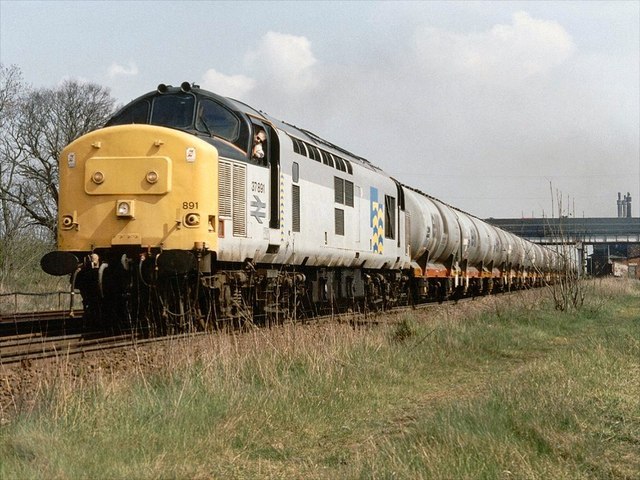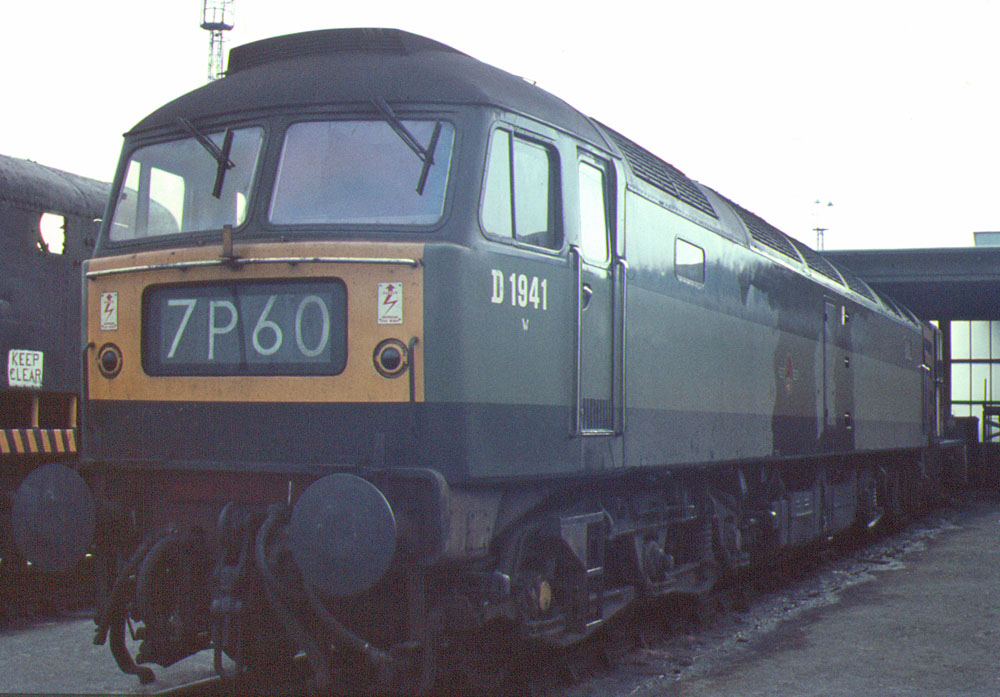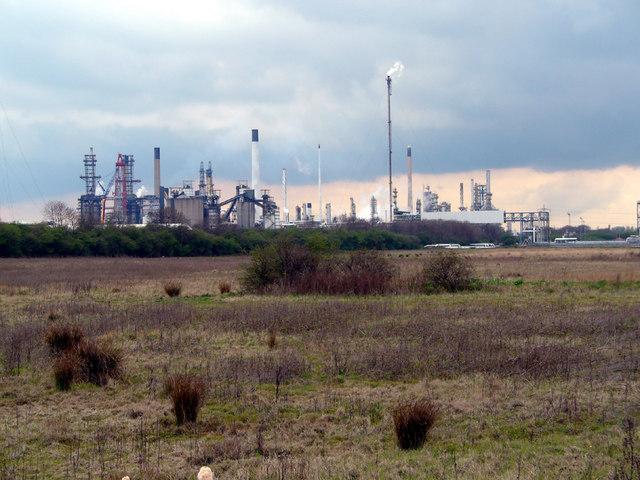|
Load-Haul
Loadhaul Ltd. was a railfreight operator based in the north-east of the United Kingdom. It was formed in 1994, as part of the privatisation of British Rail, and acquired in 1996 by a consortium headed by Wisconsin Central, then merged into a new company English Welsh & Scottish Railway. It is now part of DB Cargo. History Loadhaul was created in 1994, along with Transrail and Mainline as part of the broadly regional split of British Rail's Trainload Freight operations - Loadhaul's centre of operations were North East England, and South and East Yorkshire. The three companies were created with the aim of promoting competition between the businesses with the eventual aim of being privatised. It was initially and briefly named "Trainload Freight North East Limited" before being renamed Loadhaul Limited. All three former Trainload Freight companies including Loadhaul were acquired in February 1996 by 'North-South Railways': a company formed by a consortium led by US railroad com ... [...More Info...] [...Related Items...] OR: [Wikipedia] [Google] [Baidu] |
Trainload Freight
Trainload Freight was the sector of British Rail responsible for trainload freight services. The division was subdivided into four sub-sectors; coal, petroleum, metals and construction. It was formed in 1988 from the trainload operations of British Rail's Railfreight division. The company existed until 1994, when, as part of the privatisation process of British Rail, it was split into three separate companies by region: Load-Haul, Mainline Freight and Trans-Rail. History Trainload Freight (TLF) was created in 1988 as the sector of British Rail responsible for operating unit trains. The division was subdivided into four sub-sectors according to cargo carried: Coal, Construction, Metals, and Petroleum. Other wagonload freight activities and containerised freight were organised in the Railfreight Distribution (RfD) division at the same time. The trainload business represented approximately 80% of British Rail's total revenue from freight, and 90% of freight traffic by mass. ... [...More Info...] [...Related Items...] OR: [Wikipedia] [Google] [Baidu] |
Wisconsin Central Ltd
Wisconsin Central Ltd. is a railroad subsidiary of Canadian National. At one time, its parent Wisconsin Central Transportation Corporation owned or operated railroads in the United States, Canada ( Algoma Central Railway), the United Kingdom ( English Welsh & Scottish), New Zealand ( Tranz Rail), and Australia ( Australian Transport Network). Overview Wisconsin Central Ltd. (WC) started in US in the mid-1980s using most of the original Wisconsin Central Railway's rights of way and some former Milwaukee Road rights of way after the Soo Line Railroad acquired the Wisconsin, Illinois, Indiana, Missouri and Minnesota holdings of the bankrupt Milwaukee Road and divested its older railway trackage in Wisconsin. In 1993 the Wisconsin Central also acquired the Green Bay and Western Railroad and the Fox River Valley Railroad. In 1995, Wisconsin Central acquired the Canadian Algoma Central Railway whose tracks ran north of Sault Saint Marie to Hearst, Ontario. The Algoma Central ... [...More Info...] [...Related Items...] OR: [Wikipedia] [Google] [Baidu] |
Selby Coalfield
Selby coalfield (also known as the Selby complex, or Selby 'superpit') was a large-scale deep underground mine complex based around Selby, North Yorkshire, England, with pitheads at ''Wistow Mine'', ''Stillingfleet Mine'', ''Riccall Mine'', ''North Selby Mine'', ''Whitemoor Mine'' and at ''Gascoigne Wood Mine''; all coal was brought to the surface and treated at Gascoigne Wood, being distributed onwards by rail. The primary purpose of the pit was to supply coal for electrical power generation; much of it was used in the nearby Aire valley power stations. Mining peaked in 1993–4 at 12 million tonnes a year. The mines were acquired by RJB Mining in 1997 after the privatisation of the coal industry; loss of financial subsidy, geological problems, and low UK coal prices made the pits unprofitable by the 21st century. Closure was announced in 2002, and mining completely ceased by 2004. History In 1974, the Labour Government and National Coal Board (NCB), backed by the Nationa ... [...More Info...] [...Related Items...] OR: [Wikipedia] [Google] [Baidu] |
British Rail Class 60
The British Rail Class 60 is a class of Co-Co heavy freight diesel-electric locomotives built by Brush Traction. They are nicknamed ''Tugs'' by rail enthusiasts. During the 1980s, it became increasingly apparent that British Rail required a more capable Type 5 locomotive for its heavy freight trains. Dissatisfaction with the British Rail Class 56's reliability led to the stipulation of a 95 percent availability, a stringent requirement at the time. A total of three bids were received to a competitive tender issued on 10 August 1987; of these, Brush Traction's submission was selected and an order for 100 locomotives was issued during the following year. Despite the first example being completed during June 1989, due to a number of technical issues discovered during testing, the first examples of the Class 60 would not enter revenue service until late 1990. Operated only during the final years of British Rail, the entire Class 60 fleet became the property of English Welsh & Sc ... [...More Info...] [...Related Items...] OR: [Wikipedia] [Google] [Baidu] |
British Rail Class 56
The British Rail Class 56 is a type of diesel locomotive designed for heavy freight work. It is a Type 5 locomotive, with a Ruston-Paxman power unit developing 3,250 bhp (2,423 kW), and has a Co-Co wheel arrangement. Enthusiasts nicknamed them "Gridirons" (or "Grids" for short), due to the grid-like horn cover on the locomotive's cab ends fitted to nos. 56056 onwards. Under its Romanian railway factory nomenclature, the locomotive was named Electroputere LDE 3500, with LDE coming from ''Locomotivă Diesel-Electrică'' (Diesel-Electric Locomotive) and the 3500 being the planned horsepower output. The Class 56 fleet was introduced between 1976 and 1984, a total of 135 examples were manufactured. The first 30 locomotives (56001 - 56030, factory classification LDE3500) were built by Electroputere in Romania, but these typically suffered from poor construction standards and many were withdrawn from service early for extensive rebuilding before re-entering revenue service. The ... [...More Info...] [...Related Items...] OR: [Wikipedia] [Google] [Baidu] |
British Rail Class 47
The British Rail Class 47 or Brush Type 4 is a class of diesel-electric locomotive that was developed in the 1960s by Brush Traction. A total of 512 Class 47s were built at Brush's Falcon Works in Loughborough and at British Railways' Crewe Works between 1962 and 1968, which made them the most numerous class of British mainline diesel locomotive. They were fitted with the Sulzer 12LDA28C twin-bank twelve-cylinder unit producing though this was later derated to to improve reliabilityand have been used on both passenger and freight trains on Britain's railways for over 55 years. Despite the introduction of more modern types of traction, a significant number are still in use, both on the mainline and on heritage railways. As of December 2021, 78 locomotives still exist as Class 47s, including 31 which have been preserved. 33 further locomotives were converted to Class 57s between 1998 and 2004. Origins The Class 47 history begins in the early 1960s with the stated aim o ... [...More Info...] [...Related Items...] OR: [Wikipedia] [Google] [Baidu] |
British Rail Class 37
The British Rail Class 37 is a diesel-electric locomotive. Also known as the English Electric Type 3, the class was ordered as part of the British Rail modernisation plan. They were numbered in two series, D6600–D6608 and D6700–D6999. The Class 37 became a familiar sight on many parts of the British Rail network, in particular forming the main motive power for InterCity services in East Anglia and within Scotland. They also performed well on secondary and inter-regional services for many years. Many are still in use today on freight, maintenance, and empty stock movement duties. The Class 37s are known to some railway enthusiasts as " tractors", a nickname given due to the similarities between the sound of the Class 37's engine and that of a tractor. Description Background As part of the large scale dieselisation brought about by the British Rail modernisation plan a need was identified for a number of type 3 locomotives of power output to . English Electric ... [...More Info...] [...Related Items...] OR: [Wikipedia] [Google] [Baidu] |
Railfan & Railroad
''Railfan & Railroad'' is an American monthly magazine that has been in publication since the 1970s. It was the first magazine title established in-house by Carstens Publications. As a magazine dedicated to trains and rail transportation, it stands out from its main competitor ''Trains'' as a publication focused on the enthusiast and related activities. Established in 1974 as ''Railfan'' magazine (ISSN 0098-0714), it merged in 1979 with ''Railroad'' magazine, which Carstens purchased at that time. The magazine was renamed ''Railfan & Railroad'', but the two former titles were listed separately on the masthead until 2015. The magazine was acquired by White River Productions in September 2014. The magazine is produced monthly, edited by Steve Barry. Founding and early days As early as 1968, future ''Railroad Model Craftsman'' editor Tony Koester visited publisher Harold Carstens to pitch an idea for a "railfan's" magazine, at the insistence of his friend Jim Boyd (who was at the ... [...More Info...] [...Related Items...] OR: [Wikipedia] [Google] [Baidu] |
East Midlands Oil Province
The East Midlands Oil Province, also known as the East Midlands Petroleum Province, covers the petroliferous geological area across the north-eastern part of the East Midlands of England that has a few small oil fields. The largest field in the province is the Welton oil field, the second largest onshore oil field in the UK. Geography It comprises Lincolnshire, North Lincolnshire, Nottinghamshire and northern Leicestershire. History UK oil production The UK's first oil field was discovered in the East Midlands, at Hardstoft in east Derbyshire in 1919. Prior to this, from 1851, oil shale in the Midland Valley in Scotland was used, until 1962. With North Sea oil, Britain became self-sufficient with oil and became a net exporter of oil in 1981, with exports peaking in 1985 and production peaking in 1999. The UK became a net exporter of gas in 1997 and a net importer of gas in 2004, and also a net importer of oil in 2004. UK consumption of petroleum increases each year. Per capi ... [...More Info...] [...Related Items...] OR: [Wikipedia] [Google] [Baidu] |
Humber Refinery
The Humber Refinery is a British oil refinery in South Killingholme, North Lincolnshire. It is situated south of the railway line next to the A160; Total's Lindsey Oil Refinery is north of the railway line. It is situated approximately ten miles north west of Grimsby, and processes approximately of crude oil per day. It is owned by Phillips 66 since the split of ConocoPhillips on 1 May 2012 History At the time of construction Continental Oil (Conoco) owned the Jet distributor of petrol. Jet was formed in 1953 and was based nearby in Keadby in northern Lincolnshire. In June 1961 Continental Oil bought Jet Petroleum, and its 400 garages. In 1960 Continental had bought the German petrol company Sopi, and its 300 garages. The refinery was first planned in July 1964, and in August 1964 it was expected to cost £15 million, and to be operational by late 1966. Construction Construction started in August 1966. It was built for Continental Oil (UK) Ltd. It was originally es ... [...More Info...] [...Related Items...] OR: [Wikipedia] [Google] [Baidu] |
Lindsey Oil Refinery
Lindsey Oil Refinery is an oil refinery in North Killingholme, North Lincolnshire, England owned and operated by the Prax Group. It lies to the north of the Humber Refinery, owned by rival oil company Phillips 66, and the railway line to Immingham Docks. Immingham Power Station, owned by VPI Immingham, provides the electricity and heat for the fractionation processes. History and operation The refinery entered service in May 1968 as a joint project between Total and Fina and currently employs a permanent staff of around 415, as well as several hundred contractors on site, rising to up to several thousand during major turnaround and maintenance projects. It is named after the former Lindsey pre-1974 local government area of Lincolnshire. In 1999, Total took full control of the plant, when it bought Fina. Producing around 35 types of product, it currently processes circa 113,000 barrels of oil per day after its refining capacity was almost halved during restructuring initiative ... [...More Info...] [...Related Items...] OR: [Wikipedia] [Google] [Baidu] |




.jpg)


